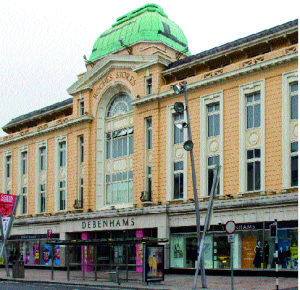Roches Stores, Patrick’s Street, Cork
Published in Gems of Architecture, Issue 1 (January/February 2015), Volume 23
Roches Stores, Cork—the outstanding feature of the building is its copper-covered dome. (Shannon Images)
The deliberate burning of nearly five acres of Cork by Auxiliaries on the night of 11–12 December 1920 left a trail of debris and ruin in the city. Patrick’s Street traders sought, and successfully accessed, compensation for their losses. Chief amongst the traders was William Roche (d. 1939), who had developed his business from a small warehouse premises on 29–32 Merchant Street in 1900 to London House at 15 Patrick’s Street.
Roches Stores (1924–5), designed by Chillingworth and Levie, 11 South Mall, was the largest of the new shops, the premises extending over the sites of four buildings destroyed in the fire. In addition to its commercial space, the new building housed government offices on its upper floors. The front elevation is nine bays wide with a pedimented central breakfront and canted half-bays at either end. Chillingworth and Levie used a generic Classical style based on a palatial elevation with a ground floor, two tiers of upper floors and an attic storey. The elevation is centred on a pedimented niche decorated with a collection of loose Classical references, typical of the transitional period before historical styles gave way to the Modern Movement and common for this type of commercial architecture. The outstanding feature of the building is its copper-covered dome.
The general influence of the designs of London’s Harrods (1905–12) and Selfridges (1909) may be seen in the vertical divisions of the elevation and the dome. A single shopfront, originally divided by brass mullions, also reflected the impact of the great London department stores and featured in other reconstructions in Patrick’s Street. The aspirations of the proprietor are seen not only in the scale of the building and its dome but also in the sourcing of shop fittings from some of the best British shop-fitting firms of the day. Cork City and County Archives’ collection includes specifications from these companies and many other details showing the level of craftsmanship that was involved. The finish was largely in brass, bronze, cast iron and hardwoods.
Of the eight shops rebuilt, only Roches Stores and Alex Grant and Co. (1923) by J.F. McMullen and Son were completed in plaster. The others used limestone, with Henry Hill’s Cash and Co. (1924–5) being the most notable example. Chillingworth and Levie also designed O’Regan and Co. (1921) at 26 Patrick’s Street, 33–34 Patrick’s Street and the Winthrop Arcade (1924–6).
While the burning of Cork was a hugely traumatic event resulting in significant economic hardship, the ensuing reconstruction of much of Patrick’s Street gave the city’s main thoroughfare a facelift. For Roches Stores it consolidated a growing business that thrived until 2006, when it was taken over by the Debenhams group.
Louise M. Harrington is an architectural and landscape historian who recently curated the ‘Chillingworth and Levie: 20th-Century Architecture in Cork’ exhibition at Cork City and County Archives. Series based on the National Inventory of Architectural Heritage’s ‘building of the month’, www.buildingsofireland.ie.
















